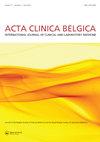Body mass index and occupational accidents among health care workers: in BMI we must trust?
IF 0.9
4区 医学
Q2 Medicine
引用次数: 0
Abstract
I like to make some comments and remarks on the publication by Fraeyman et al. (2022) entitled ‘Body mass index and occupational accidents among health care workers in a large university hospital’ [1]. Besides the well-known obesity-related health risks, the obesity-related safety risks are worth to be investigated because of the significant proportion of the workforce is struggling with overweight and obesity. I will focus on the use of the body mass index (BMI), the multifactorial origin of obesity and accidents, the causality and the biological plausibility of the correlation. BMI is a measure of weight adjusted for height. It is a ‘surrogate’ measure of body fat because it measures excess weight rather than excess fat. It is a simple, inexpensive, and non-invasive measure of body fat. BMI can be routinely measured and calculated with reasonable accuracy, e.g. in an occupational health care setting. The clinical limitations should be considered. Age, sex, ethnicity, and muscle mass can influence the relationship between BMI and body fat. Also, BMI does not distinguish between excess fat, muscle or bone mass, nor does it provide any indication of the distribution of fat among individuals. BMI should serve as the ‘initial’ screening of overweight and obesity. Other factors, such as fat distribution, genetics, and fitness level, should be considered. Measuring waist circumference could be seen as a good alternative or a supplementary measurement to BMI calculation, especially among the working, muscular, adult population [2–5]. That all being said, exact values of BMI are still disputed (e.g. for Afro-Americans and Asian persons). But, if one uses the BMI classification as proposed by the World Health Organization for epidemiological purposes, one must stick to the WHO definitions. Although, Fraeyman and colleagues used on page 3 the classification ‘underweight’ for BMI < 20 kg/m, but that must be < 18.5 kg/m. Also using the classification ‘morbid obesity’ is obsolete, must be ‘Class III Obesity” with a BMI of ≥40 kg/m, or ≥35 kg/m with experiencing obesityrelated health problems [6]. One must further conclude that a (little) overweight is not the same as obesity. One must keep in mind that an occupational accident is mostly caused by a myriad of risk factors, as the origin of obesity is multifactorial. It is too bluntly to try to link these two items without taking account of plenty possible confounders of both. The wellestablished shiftwork and obesity relationship could be a confounding factor . . . Or the many comorbidities of obesity (chronic health conditions as sleep apnea syndrome) could be confounding. Many indirect risk factors could be associated among HCWs, e.g. psychosocial factors like work stress, work relationships, work satisfaction, to mention a few. THE health care worker does not exist because it is obviously a container concept. The functional classes A-D of HCWs by Fraeyman et al. could be a too great simplification of the diverse, real functional tasks and jobs in a university hospital setting. A large proportion of health care workers (HCWs) are females and thus have a different fat distribution than males. Further, even if an association was found, that does not necessarily mean a causal association. For example, a clear dose–response relationship must be preferable demonstrated (an important Bradford-Hill criterium). But, the mechanisms remain often unclear [7]. Koepp et al. (2015) hypothesized that related physical limitations, fatigue and chronic medical conditions were the factors leading to a higher risk of occupational injuries such as slip, trip and fall injuries [8]. Is there a direct relationship between obesity and occupational injuries? Is obesity a relevant and prominent risk factor? No, because obesity alone is unlikely to be a necessary or a sufficient risk factor for occupational injuries [9]. Biological plausibility and causality need to be eludicated, before putting a ‘statistical stigma’ on those workers with overweight and accidents [10]. Still, the most salient and modifiable risk factors for occupational accidents, namely those related to job design and tasks, physical environmental and sociocultural factors, need to be addressed first of all. That will lead to overall safety for all employees, regardless of weight. Preventative interventions (e.g. weight-loss strategies) at the workplace are useful, although in the first place to prevent health-related issues linked with obesity.医疗工作者的身体质量指数与职业事故:我们必须相信身体质量指数?
本文章由计算机程序翻译,如有差异,请以英文原文为准。
求助全文
约1分钟内获得全文
求助全文
来源期刊

Acta Clinica Belgica
医学-医学:内科
CiteScore
2.90
自引率
0.00%
发文量
44
审稿时长
6-12 weeks
期刊介绍:
Acta Clinica Belgica: International Journal of Clinical and Laboratory Medicine primarily publishes papers on clinical medicine, clinical chemistry, pathology and molecular biology, provided they describe results which contribute to our understanding of clinical problems or describe new methods applicable to clinical investigation. Readership includes physicians, pathologists, pharmacists and physicians working in non-academic and academic hospitals, practicing internal medicine and its subspecialties.
 求助内容:
求助内容: 应助结果提醒方式:
应助结果提醒方式:


